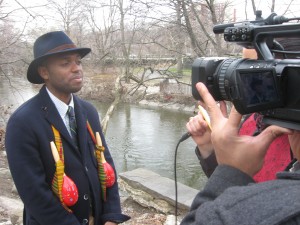
By Lulaine Compere
Morgan Powell has been on a nine-year mission — researching, traveling and interviewing people about the history of African Americans in the Bronx. He estimates, conservatively, that he has spent $8000 to bring this story to life.
In the spring, Powell partnered with the Bronx River Alliance and held a free two-hour walking tour along the Bronx River to highlight certain places and people that are important to the African American history in the area. And two Saturdays ago at the Bronx Library Center, Powell turned his walking tour into a presentation called “The Bronx River’s Afro-American Heritage in 100 Golden Moments.”
“The point of this project was to write African American history into a story people might think they know about the Bronx River,” Powell says, adding: “African Americans are the second biggest ethnic group in the Bronx.”
Powell says the walking tour wasn’t his original idea. But when someone at the Bronx River Alliance suggested it, Powell decided to do it. Currently there are no plans to extend the walking tour or expand it to other parts in the Bronx. In the future, Powell says he wants to publish academic essays about the Bronx’s African American history.
“Pictures and walking tours are good, but they are limited,” he said. “If it is to make history in academics it has to be printed.”
The reaction to the project has been overwhelmingly positive, Powell says.
“The positive responses have been staggering. I must have gotten 40 messages through phone calls, emails and they have been diverse,” he said. “I have gotten messages from African Americans who are happy that African American history in the area is being investigated and people are being challenged to know about it.”
Powell has been involved in many environmental issues and was once manager of a local city park. He hopes more people connect with the Bronx River corridor because he says it will only be a priority if the people make it one.
“It’s all about nursing that relationship,” he says. “People are already paying for the Bronx River corridor. There has not been proportionate interest like for other areas and elected officials will only make it a priority if they believe it is a priority for their constituents.”
Powell also hopes that the tour and the other projects related to the tour will push the knowledge of the civil rights movement African Americans supported in the North, which is not as widely known as the civil rights movement in the South.
“Yes, I definitely see, even in my own education, the portrayal of the civil rights as exclusively in the South,” he says. “The only exception was the limited discussion of Malcolm X and Adam Clayton Powell in Harlem. I was told nothing about civil rights in the Bronx and I want to help reconnect people with that history and the Bronx River.”
Highlights from Powell’s Tour
— Bronx Park, near Allerton ballfields: The tour stopped here to explain what it was like for slaves to be in this area before trains, telephones and newspapers. Powell explained what it was like to move to the area when the only major road was Boston Road and other small dirt roads.
— Vanished American Revolutionary War fort Site at the intersection of Mosholu Parkway and Grand Concourse, at St. George’s Crescent: This stop on the tour was where freemen of Virginia who were promised their freedom by the British fought Americans from this fort until the Americans captured it.
— Old Train Tracks of the Harlem and New Haven line located at the Metro North’s Williamsbridge station: A mob of men angry about being drafted into the Civil War destroyed the telegraph offices here and ripped up tracks to prevent the operation of the federal draft.
— French Charlie Park’s House and Station: This tour stop illustrated some of the nuances and economic consequences of Bronx slavery before it became illegal in 1827, at which time the Bronx was still part of lower Westchester.





Morgan Powell has done a fantastic job in unearthing the history of African-Americans in the Bronx, along the Bronx River and in the environmental movement. His efforts are making it clear that the saga of African-Americans should not be forgotten. “Never Again” resonates cross culturally in his work and is a lesson to all people.
Thanks Norwood News for bringing this story to those who may not yet have experienced a Bronx African History Project program which are also on-line including videos. There are a few Bronx River Sankofa talks and a walk scheduled for early 2012 posted at http://www.facebook.com/pages/Bronx-River-Sankofa/142834315808816?sk=info I owe all who crave historical accuracy that there were newspapers in the 1820s. It’s just that daily ones were rare and even the wealthy of what is now the Bronx were more likely to have access to pro-slavery weekly and quarterly printed media. Also, those who want to read a book about the Bronx River’s ecological, economic and social past may enjoy the new Bronx River book by Maarten De Kadt published by the History Press. Thank you